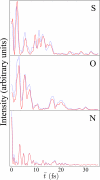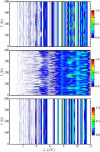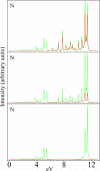Nonlinear light scattering in molecules triggered by an impulsive X-ray Raman process
- PMID: 24465122
- PMCID: PMC3900012
- DOI: 10.1103/PhysRevA.87.053826
Nonlinear light scattering in molecules triggered by an impulsive X-ray Raman process
Abstract
The time-and-frequency resolved nonlinear light scattering (NLS) signals from a time evolving charge distribution of valence electrons prepared by impulsive X-ray pulses are calculated using a superoperator Green's function formalism. The signal consists of a coherent ~ N2-scaling difference frequency generation and an incoherent fluorescence ~ N-scaling component where N is the number of active molecules. The former is given by the classical Larmor formula based on the time-dependent charge density. The latter requires additional information about the electronic structure and may be recast in terms of transition amplitudes representing quantum matter pathways.
Figures








Similar articles
-
Photon entanglement signatures in difference-frequency-generation.Opt Express. 2009 Jan 19;17(2):1093-106. doi: 10.1364/oe.17.001093. Opt Express. 2009. PMID: 19158927 Free PMC article.
-
Multidimensional optical spectroscopy of a single molecule in a current-carrying state.J Chem Phys. 2010 Dec 28;133(24):244106. doi: 10.1063/1.3517218. J Chem Phys. 2010. PMID: 21197975 Free PMC article.
-
Coherent (photon) vs incoherent (current) detection of multidimensional optical signals from single molecules in open junctions.J Chem Phys. 2015 Jun 7;142(21):212445. doi: 10.1063/1.4919955. J Chem Phys. 2015. PMID: 26049465
-
Electronic Population Transfer via Impulsive Stimulated X-Ray Raman Scattering with Attosecond Soft-X-Ray Pulses.Phys Rev Lett. 2020 Aug 14;125(7):073203. doi: 10.1103/PhysRevLett.125.073203. Phys Rev Lett. 2020. PMID: 32857563
-
Ab initio calculation of X-ray and related core-level spectroscopies: Green's function approaches.Phys Chem Chem Phys. 2022 Jun 8;24(22):13461-13473. doi: 10.1039/d2cp01167k. Phys Chem Chem Phys. 2022. PMID: 35616020 Review.
Cited by
-
Imaging electron-density fluctuations by multidimensional X-ray photon-coincidence diffraction.Proc Natl Acad Sci U S A. 2019 Jan 8;116(2):395-400. doi: 10.1073/pnas.1816730116. Epub 2018 Dec 24. Proc Natl Acad Sci U S A. 2019. PMID: 30584098 Free PMC article.
-
Probing electronic and vibrational dynamics in molecules by time-resolved photoelectron, Auger-electron, and X-ray photon scattering spectroscopy.Faraday Discuss. 2015;177:405-28. doi: 10.1039/c4fd00178h. Epub 2015 Mar 2. Faraday Discuss. 2015. PMID: 25730500 Free PMC article.
-
Cascading and local-field effects in non-linear optics revisited: a quantum-field picture based on exchange of photons.J Chem Phys. 2014 Jan 28;140(4):044313. doi: 10.1063/1.4862236. J Chem Phys. 2014. PMID: 25669529 Free PMC article.
-
Time-, frequency-, and wavevector-resolved x-ray diffraction from single molecules.J Chem Phys. 2014 May 28;140(20):204311. doi: 10.1063/1.4878377. J Chem Phys. 2014. PMID: 24880284 Free PMC article.
References
-
- Ullrich J, Rudenko A, Moshammer R. Ann. Rev. Phys. Chem. 2012;63:635. http://www.annualreviews.org/doi/abs/10.1146/annurev-physchem-032511-143720. - DOI - PubMed
-
- Gallmann L, Cirelli C, Keller U. Ann. Rev. Phys. Chem. 2012;63:447. http://www.annualreviews.org/doi/abs/10.1146/annurev-physchem-032511-143702. - DOI - PubMed
-
- Emma P, Akre R, Arthur J, Bionta R, Bostedt C, Bozek J, Brachmann A, Bucksbaum P, Coffee R, Decker FJ, Ding Y, Dowell D, Edstrom S, Fisher A, Frisch J, Gilevich S, Hastings J, Hays G, Hering Ph, Huang Z, Iverson R, Loos H, Messerschmidt M, Miahnahri A, Moeller S, Nuhn HD, Pile G, Ratner D, Rzepiela J, Schultz D, Smith T, Stefan P, Tompkins H, Turner J, Welch J, White W, Wu J, Yocky G, Galayda J. Nat. Photon. 2010;4:641. ISSN 1749-4885, http://dx.doi.org/10.1038/nphoton.2010.176. - DOI
-
- Kapteyn H, Cohen O, Christov I, Murnane M. Science. 2007 Aug;317:775. ISSN 0036-8075, 1095-9203, http://www.sciencemag.org/content/317/5839/775. - PubMed
-
- Krausz F, Ivanov M. Rev. Mod. Phys. 2009 Feb;81:163. http://link.aps.org/doi/10.1103/RevModPhys.81.163. - DOI
Grants and funding
LinkOut - more resources
Full Text Sources
Other Literature Sources
